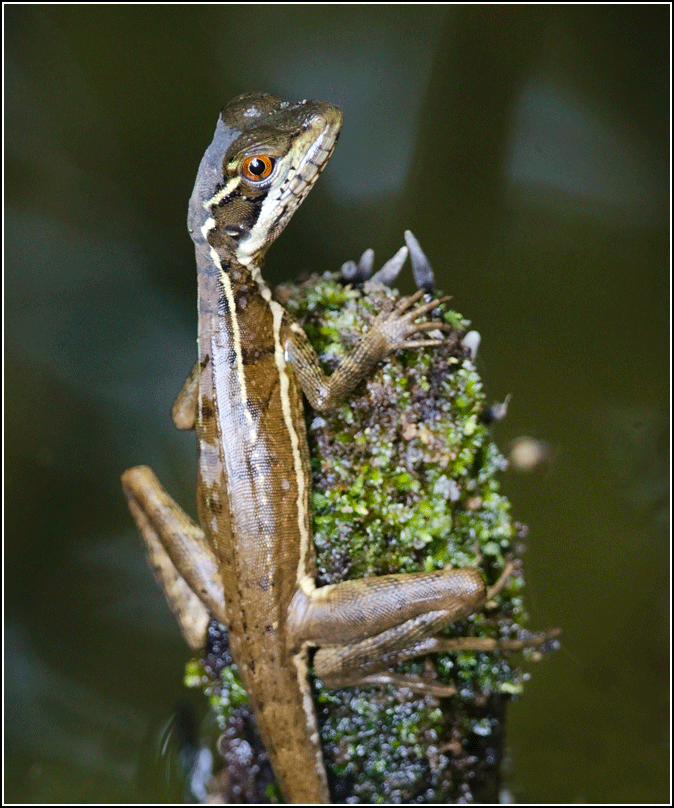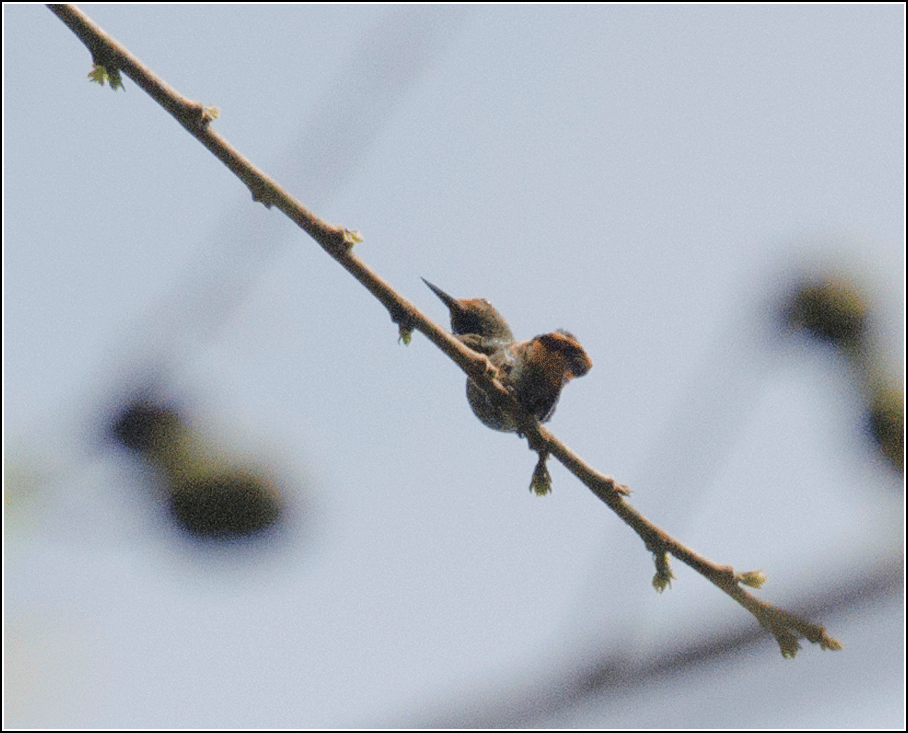----------------------------------------------------
The plan for our second full day was to bird Old Gamboa Road which is located at the edge of Soberania National Park. This used to be the main road into Gamboa but it is no longer being used. The southern end of the road is very productive for birding as it passes through dry forest and scrub, grassy areas and creek valleys. We were hoping to find some of the target birds found in the dry scrub/forest habitat, such as Rosy Thrush-Tanager, Pale-eyed Pygmy-Tyrant, Jet Antbird and Lance-tailed Manakin.
 |
| Lesser Kiskadee - Old Gamboa Road, Panama |
Quite a few birds were active as we arrived early in the morning. Flycatchers such as Great Kiskadee, Tropical Kingbird, Boat-billed Flycatcher, and Rusty-margined Flycatcher were present along the roadsides, and Summer Tanagers, various warblers and tanagers were in the treetops as well, while several species of wren (Black-bellied, Rufous-and-white, Buff-breasted, House, and Rufous-breasted) called from the undergrowth.
 |
| Great Kiskadee - Old Gamboa Road, Panama |
The calls of several trogon species and Whooping Motmots echoed from back in the forest as the sun rose. With it only being my second full day in the tropics, I was still getting used to seeing a crazy looking bird like a Whooping Motmot on the side of the road! Just a few days earlier the only birds I was seeing were European Starlings, House Sparrows, and Ring-billed Gulls...
 |
| Whooping Motmot - Old Gamboa Road, Panama |
We stopped by at the Summit Ponds, located at the start of the south section of Old Gamboa Road. This can be a great spot for wading birds and is usually pretty reliable for Boat-billed Heron, which is nocturnal and not always easily seen. I was pretty happy to see a few of them across the pond. They are basically a Black-crowned Night-Heron with a massive bill!
 |
| Boat-billed Heron - Old Gamboa Road, Panama |
We also had a flock of Greater Anis here and a few new trip birds (and lifers for me!) such as Fulvous-vented Euphonia, Lesser Kiskadee, Mangrove Swallow, etc.
 |
| nesting Mangrove Swallow - Old Gamboa Road, Panama |
The south end of the road was no longer in use and was slowly being reclaimed by the forest in sections. Other parts were open, and for the majority of its length it was very easy walking, leading to awesome birding! While we missed Rosy Thrush-Tanager and Jet Antbird we did see many of the other dry scrub specialties. Species that stood out to me for whatever reason included Blue-black Grosbeak, Tawny-throated Leaftosser, Fasciated Antshrike, and Buff-throated Saltator.
 |
| female Fasciated Antshrike - Old Gamboa Road, Panama |
While we were walking and birding I almost stepped on a small turtle, just sitting in the middle of a road. It was a Mud Turtle! Ibelieve it is Kinosternon leucostomum, the White-lipped Mud Turtle.
 |
| Kinosternon leucostomum - Old Gamboa Road, Panama |
 |
| Kinosternon leucostomum - Old Gamboa Road, Panama |
Mud Turtles are notorious for being really shy when encountered making them a tough photo subject! I waited for about 15 minutes for it to come out of its shell but it was quite wary, retreating if I was within "shooting" range. Very cool turtle, though!
 |
| Kinosternon leucostomum - Old Gamboa Road, Panama |
After a solid morning of birding we reached the south end of the road with a day list around 100 species. It was now mid morning and the sun was getting high in the sky. The morning flight of vultures began, and it wasn't long before we picked out Swainson's Hawks, Broad-winged Hawks, and Plumbeous Kites flying as well. The highlight though was a brief flyby of a Black Hawk-Eagle, a species that had been seen occasionally along Old Gamboa Road. Luckily I had my camera on me and managed a few poor record shots of the awesome bird.
 |
| Vulture kettle - Old Gamboa Road, Panama |
 |
| Black Hawk-Eagle - Old Gamboa Road, Panama |
Raptor migration can be pretty incredible in Panama since the shape of Central America concentrates the birds. Without really trying too hard we managed 9 species of raptor/vulture in about an hour!
Several fruiting trees along the south end of the road had attracted a variety of honeycreepers and hummingbirds, such as this Black-throated Mango.
 |
| Black-throated Mango - Old Gamboa Road, Panama |
I photographed a few insects, including this bad-ass caterpillar. Wow!
 |
| caterpillar - Old Gamboa Road, Panama |
By late morning we returned to the start of the road. The temperature had, not surprisingly, risen to about 30 degrees Celsius, just what we expectedfor the lowlands. While songbird activity quieted down we had a cool experience with a raptor.
This Crane Hawk was working its way along the trees adjacent to the paved section that sees vehicle traffic. This species reminds me of an Accipiter somewhat - almost like a melanistic Cooper's Hawk . Luckily for us, it did not seem to mind our presence, allowing us to approach closely for photos! The lighting at this time of day was obviously not ideal making it a real challenge to expose the image properly.
 |
| Crane Hawk - Old Gamboa Road, Panama |
We birded the area for another hour or two, slowly adding species by ones and twos. By noon we had seen 119 species which might have ended up being our top morning for the entire trip. By early afternoon however we were ready to head back to Gamboa to rest up for a few hours during the heat of the day.
That afternoon we were relaxing in the room drinking some beers and checking out our photos. Before long though we were distracted by the Geoffroy's Tamarins which had descended upon a feeding tray in the backyard of our hosts. They would come out of the nearby woods and take pieces of fruit by hand from us , acting pretty comical to say the least.
 |
| Geoffroy's Tamarin - Gamboa, Panama |
 |
| Geoffroy's Tamarin - Gamboa, Panama |
I only had my long lens on my camera, making it difficult to fit them in the frame. Check out that face...
 |
| Geoffroy's Tamarin - Gamboa, Panama |
Or this one!
 |
| Geoffroy's Tamarin - Gamboa, Panama |
That afternoon we decided to drive over to the Ammo Ponds, located just outside of Gamboa. These ponds, across the road from the Panama Canal, are fantastic locations to find interesting herons, rails, and ducks. While we did not come across anything too rare during our visit, there were some interesting things to see! The afternoon clouds had rolled in making for comfortable birding.
Yellow-tailed Oriole was one bird that I was really hoping to see, and we found our first ones at the Ammo Ponds including some which likely had a nest nearby.
 |
| Yellow-tailed Oriole - Ammo Ponds, Gamboa, Panama |
 |
| Yellow-tailed Oriole - Ammo Ponds, Gamboa, Panama |
The Banded Orange Heliconian is a common species that can be found from Brazil all the way to the United States, and they are reasonably common in Panama. A few were patrolling the plants along the edge of the road near the Ammo Ponds.
 |
| Banded Orange Heliconian - Ammo Ponds, Gamboa, Panama |
 |
| Banded Orange Heliconian - Ammo Ponds, Gamboa, Panama |
Since we were right next to the Panama Canal several species of seedeaters were feeding in the open areas. Yellow-bellied was the common one though there were a few Variable Seedeaters mixed in.
 |
| seedeaters - Ammo Ponds, Gamboa, Panama |
We decided to walk along the beginning of Pipeline Road for the hour or two before dusk. At one point I found a Brownish Twistwing, a rather drab, dark brown species that is named for its behaviour of lifting each wing in succession over its back and down again. Another bird I was looking forward to seeing after reading about it in field guides, even though it wasn't the flashiest.
Steve and I came across this very photogenic Black-crowned Antshrike which was foraging close to the road. This species is rather common in many areas and often accompanies antwrens, warblers, tanagers, woodcreepers, and antbirds in mixed flocks.
 |
| Black-crowned Antshrike - Pipeline Road, Panama |
Later that evening after eating dinner, Dave and I decided to take the rental and drive down Pipeline Road, while Steve stayed behind to organize his stuff. For the first few kilometers the road was drivable, and we stopped periodically to listen to owls. A major highlight occurred when a Northern Tamandua crossed the road right in front of us. Not only that, but a baby was clinging on to its back.
Eventually we reached a spot where we couldn't continue and walked down the road. I kept an eye out for reptiles or amphibians, but with the dry conditions not much of anything was around.
As we walked down into creek valleys, owls suddenly became apparent. The majority of the ones we heard vocalizing were Crested Owls and Mottled Owls, though Tropical Screech Owls were also in a few spots. It seemed that every creek valley had an owl or two calling and eventually Black-and-white, Spectacled, and Vermiculated Screech Owls were all heard. A few Common Potoos also called, a first for me!
While on the long walk back to the car, Dave and I found an interesting looking opossum on some waist-height vegetation, which turned out to be a Water Opossum, the only species in its genus, Chironectes. This is a pretty secretive species that is usually only seen at night, so I've read.
When it was all said and done, Dave and I had heard:
12 Crested Owls
8 Mottled Owls
3 Tropical Screech Owls
1 Spectacled Owl
1 Black-and-white Owl
1 Vermiculated Screech Owl
Earlier in the day we had also seen a Striped Owl flying across the Panama Canal at dusk, making it a 7 owl day. A great finish to an awesome second day in the canal zone!
Total bird species so far: 204


























